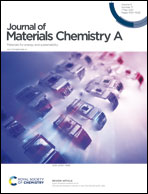Unprecedentedly high efficiency for photocatalytic conversion of methane to methanol over Au–Pd/TiO2 – what is the role of each component in the system?†
Abstract
Direct and highly efficient conversion of methane to methanol under mild conditions still remains a great challenge. Here, we report that Au–Pd/TiO2 could directly catalyze the conversion of methane to methanol with an unprecedentedly high methanol yield of 12.6 mmol gcat−1 in a one-hour photocatalytic reaction in the presence of oxygen and water. Such an impressive efficiency is contributed by several factors, including the affinity between Au–Pd nanoparticles and intermediate species, the photothermal effect induced by visible light absorption of Au–Pd nanoparticles, the employment of O2 as a mild oxidant, and the effective dissolution of methanol in water. More importantly, for the first time, thermo-photo catalysis is demonstrated by the distinct roles of light. Namely, UV light is absorbed by TiO2 to excite charge carriers, while visible light is absorbed by Au–Pd nanoparticles to increase the temperature of the catalyst, which further enhances the driving force of corresponding redox reactions. These results not only provide a valuable guide for designing a photocatalytic system to realize highly efficient production of methanol, but also, highlight the great promise of thermo-photo catalysis.



 Please wait while we load your content...
Please wait while we load your content...